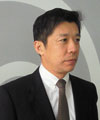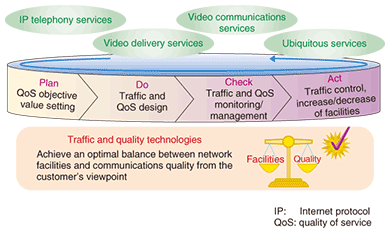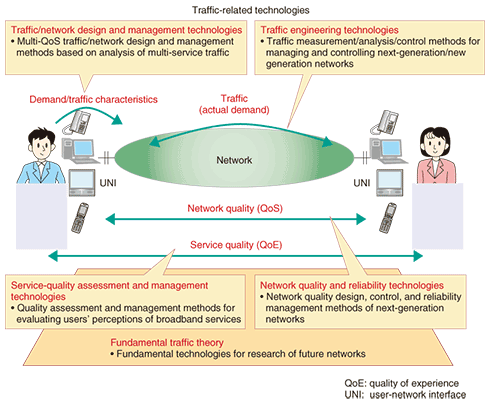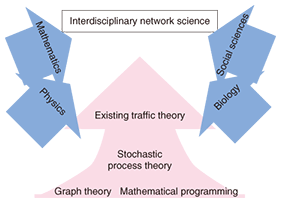 |
|
|
|
|
|
Front-line Researchers Vol. 9, No. 2, pp. 1–6, Feb. 2011. https://doi.org/10.53829/ntr201102fr1  Researching What Should Be ResearchedOverviewHiroshi Saito, an NTT Senior Distinguished Researcher, was the first in the world to propose Interdisciplinary Network Science as a field that attempts to systematically bring together existing traffic theories. We asked him about the present state of traffic research and the future outlook for this field. Traffic research today—Dr. Saito, what exactly is communications traffic? Well, since traffic in communications is something that we cannot see with the naked eye, we can draw an analogy with traffic on city streets. To begin with, communications traffic design corresponds to street design in which the number of lanes expected to be needed must be determined. We can see how, if only one lane is provided, the arrival of many cars will result in a huge traffic jam. Communications traffic control, meanwhile, corresponds to the switching between red and green traffic signals. Here, we can imagine the traffic jam that would ensue at an intersection if the intersecting road with fewer cars were given a long green light and while the other road were made to endure a red light for the same period of time. Now, lying between design and control, there is also traffic management or simply traffic monitoring, which serves to measure present conditions and take immediate measures. In a similar manner, the state of major traffic intersections is continuously monitored. Here, the extent of congestion and the waiting time required at an intersection as well as the time needed to arrive at the destination are all related to quality. Finally, traffic theory is what helps to determine such traffic phenomena and execute suitable measures. Traffic theory is not so much the principles of communications but rather a set of principles supporting communications as a public service. If applied correctly, traffic theory will not only provide correct values, but also help to provide optimal control methods and system configurations (Figs. 1 and 2).
—Isn’t traffic research in Japan making good progress on the global scene? Some twenty years ago, AT&T (Bell Laboratories) in the USA had an overwhelming presence in this field in terms of the number and quality of papers and number of researchers. At that time, it was said that NTT was the next AT&T (Bell Laboratories), and with the breakup of AT&T (Bell Laboratories), I believe that NTT is leading from the global perspective. —How has traffic research progressed since you came to be involved in this field? And for that matter, how does one measure progress in traffic research? The principles of traffic theory as reflected by the formulas created by A. K. Erlang, the founder of traffic theory, have been around for more than a hundred years. But the target systems are no longer just telephones, and even in the case of telephone systems, networks have become increasingly complicated. In traffic research, the communications systems that we apply traffic theory to are changing rapidly, and our task is to ensure that mathematical theory keeps up with those changes. In the period from the 1960s to the 1980s, great progress was made in the application of mathematics in many areas of traffic research. Perhaps the fact that computers came into practical use during this period, enabling rigorous computations to be made, had a lot to do with this development. Here, the clarification of a mathematical principle in one area served to inspire and promote progress in surrounding areas. As a result, this period saw a peak in the number of papers published in the field of traffic research. And speaking of advances in systems targeted by traffic theory, we have seen great changes take place at a rate of about one new system every ten years, as reflected by the transitions from the telephone network to ISDN (integrated services digital network), ATM (synchronous transfer mode), and the Internet. There is now great variation in the equipment used and services provided by communications systems, and as target systems expand, traffic theory must expand as well. —Do you mean to say that these changes continue to this day? That’s right. During the hundred-odd years of the telecommunications business, traffic theory has played an integral role, but it is now at a turning point. This is because of the following significant changes in the business environment. (1) Customer equipment (such as personal computers) has diversified and is reaching high levels of performance and functionality with the result that control performed only within the network prevents satisfactory control from being achieved. (2) The significance of highly accurate network design has fallen with the coming of the Internet as a best-effort service and notable drops in the cost of equipment. (3) Theory cannot keep up with the changes occurring in mainstream applications. The basic assumptions and hypotheses that have held since the Erlang era are losing their validity. (4) Alternatives to traffic theory such as computer simulation are emerging. In the face of this changing environment, a number of phenomena have appeared that contradict traffic theory originating in the Erlang era. —In what direction, then, will traffic research proceed in the years to come? Looking forward, one of our concerns is the direction that traffic characteristics will take. Specifically, of great interest here is whether that direction will conform to conventional traffic theory as shown by the blue plot in Fig. 3 or be completely different as shown by the red plot. At first, many researchers predicted that traffic characteristics would take a direction completely at odds with existing traffic theory, but I am of the opinion that they have recently been returning to a direction conforming to existing traffic theory.
For example, Internet users often obtain desired information in an abrupt manner, and then, after a relatively long period of inactivity, suddenly obtain more information. This kind of activity leads to burst-like traffic characteristics. However, user traffic that has been increasing dramatically of late is of the stream type as in watching videos. In the case of stream-type traffic, the network is used in a semi-continuous manner. This means that traffic characteristics are also moving in a direction similar to that of telephone use, and in a sense, in a network-friendly direction. Of course, the dramatic increase in traffic volume requires a dramatic increase in network capacity, but in the case of a quantitative treatment, it may be possible to use methods based on existing traffic theory in an efficient manner. At the same time, traffic characteristics must be continuously monitored to see whether they are actually moving in that direction. Theoretical studies must also be performed if traffic characteristics should be found to be moving in a completely different direction. Interdisciplinary network science—Is traffic research flourishing worldwide? No, it’s not. Because of the four environmental changes I described earlier, research related to traffic theory is somewhat sluggish around the world. One major reason for this may be the slowdown in research and development (R&D) at network operators. In such an environment, we might wonder what role traffic theory will play over the next hundred years, and we can consider that traffic theory as we have known it may need to be revised. In this regard, I would like to establish interdisciplinary network science as an orderly theoretical system that incorporates elements of peripheral fields such as biology, the social sciences (economics etc.), mathematics (integral geometry etc.), and physics (statistical physics etc.) in traffic theory, which is based on stochastic process theory (statistical theory), using graph theory and mathematical programming as supplementary tools (Fig. 4).
—Are there researchers who are spurred on by the ideas that you espouse? Well, though not exactly the same, there are people in Japan researching network control using living things for reference, as in bio-inspired networking, and in the social sciences, there are people working on wireless protocol design using game theory. Workshops related to such endeavors have been held in recent years. Various types of interdisciplinary research have therefore been pursued but in a separate, independent manner. My desire is to bring these fields together in a systematic way. Researching what should be researched—Dr. Saito, how did you come to be involved in traffic research? Well, all I can say is that when I entered the company, I was simply assigned to the traffic research laboratory. Although I’ve been holding management-related positions the last ten years or so and have been in charge of ubiquitous service systems, I spent about twenty years in the traffic research laboratory. Actually, my original desire was to perform basic research on speech, but in 1983 when I entered the company, preparations were being made to set up a special laboratory for traffic research. The personnel manager called me and told me that traffic research “was on the verge of becoming a very significant field”. After he persuaded me of its importance and received my agreement, my assignment was finalized. Come to think of it, at that time the only thing I knew about NTT Laboratories was speech research, and I had not even been specializing in speech studies at school. All things aside, my career since entering the company has been involved with traffic research, which initially was an unknown world to me. I can see now that this is how a researcher can develop a specialty. —Do you find traffic research, which is always presenting new challenges, an attractive field? Have you had real feelings of achievement here? Yes, I do find it an attractive field. Network and traffic research are essential areas of research at NTT Laboratories, and I realize that I am working near the center of things. As for having real feelings of achievement, it’s hard to say. For example, when evaluating achievements in control systems, if at least one achievement has already been obtained, it will become apparent when a second achievement can be obtained. However, to obtain achievements in traffic research, you need the help of third-party developers who provide the hardware and software to make your research a reality—without them, specified targets cannot be achieved. Thus, even if journal papers have been completed and experimental results obtained, it may be some years before your research is fully implemented. In this sense, it is somewhat difficult to determine when achievements have actually been obtained. —Times in research when no clear answers can be obtained must be psychologically difficult to handle. How do you feel about this? Traffic research is not a field in which you can draw a blueprint indicating what specifically can be obtained a certain number of years later. The more difficult the research is, the more likely it is that no answers will be obtained. Of course, it’s a great relief if answers are eventually obtained. Obtaining an answer is really a great moment, but the time taken up by research to get to that answer may be quite long. We go through this all the time. Looking back twenty years or so, I think there have been only twenty or thirty such moments, some more important than others. There have also been periods when no answers at all were forthcoming and I was just wondering what to do. Such answers could not be obtained simply because I wanted to absolutely obtain such and such a result within that period, so until that moment of relief arrived, my stomach was all tied up in knots. That’s because there was no one around that could help me! (smiles). —How would you characterize your own research style? I work regular hours and take home as little work as possible. Perhaps I don’t fit the stereotype of a researcher, contrary to your expectations. A research style that is overly earnest to the point of frequently working late hours is not conducive to a healthy body. It’s like being awfully tired when studying for a test in a difficult subject during one’s student days. That’s the feeling. If you push yourself too hard, you will damage your health. The content of research is also important. I believe that it is essential to research what you should be researching. If you understand what you should be researching, I think your research is already half done. That’s why I’m always thinking about what I should be researching. At the beginning of a research phase, if a researcher can envision what will be important over the next ten years, it will become clear what to place more weight on during that research and what outputs to expect. Furthermore, as that research gradually comes to an end, the researcher should look around to determine what research to do next and then repeat the research cycle. I believe that a researcher who is very clear about what he or she should be doing next is a very fortunate person. After twenty years of continuous research, the world has become quite diversified, and I find myself in a situation in which major objectives and clear directions cannot be obtained at all. Under these circumstances, I look around again to see what research is needed. To this end, I monitor what researchers around the world are thinking and trends in peripheral fields. For this, my main survey tool is the Internet, but I think it is also important to actually meet with a variety of researchers to exchange opinions. Recently, on visits to manufacturers, research laboratories at NTT DOCOMO, overseas institutions, and university research laboratories, I’ve been able to engage in such discussions as a step prior to preparing a journal paper. In this way, I can learn more not just about traffic theory itself but also about how the targets of traffic theory are changing and how its use is changing from various perspectives, which becomes great reference material. To young researchers—On listening to what you have to say about research, it appears that researchers have a very solitary existence. Well, that depends on the type of research. Some researchers are part of a group, and I myself get research tips by talking to fellow researchers. It sometimes happens that talking to researchers with a slightly different specialty to my own can suddenly reveal a solution that previously eluded me. I don’t know if that answers your question, but I think that solitude is a problem associated with one’s frame of mind. For example, even a researcher carrying out research as a member of an organization may feel a sense of solitude. However, individual researchers who feel a sense of solitude must keep in mind that, in a research organization, 1 + 1 in terms of research output does not equal 2 but rather 3 or 4. At NTT Laboratories, total R&D strength is not simply the sum of all individual researcher expertise—individual strengths have a mutually augmenting effect on each other. This is what I would like researchers to keep in mind. —What, then, should young researchers do? Could you leave us with a message for them? Even if you’re working as if the world depended on it, leave some energy to spare. While working on research that can realistically result in output, save enough physical energy for answers to problems that potentially lie ahead. Rushing around without leaving yourself any reserve cannot last forever. In this regard, I would like young researchers to interpret the saving of energy in research work as an actual ability. You need different approaches to find an answer that is needed soon and one that will be needed far in the future. Even updating consecutive answers in a sequential manner will not necessarily result in the far-future answer. I would like young researchers to be aware of this. As I explained earlier, it’s vitally important to consider what to research next. After saving some energy for future research, I would like young researchers to always be thinking about what they should be researching. Hiroshi SaitoSenior Distinguished Researcher, NTT Service Integration Laboratories. He received the B.E. degree in mathematical engineering, the M.E. degree in control engineering, and the Dr.Eng. degree in teletraffic engineering from the University of Tokyo in 1981, 1983, and 1992, respectively. He joined Nippon Telegraph and Telephone Public Corporation (now NTT) in 1983. He received the Young Engineer’s Award from the Institute of Electronics, Information and Communication Engineers (IEICE) of Japan in 1990, the Telecommunication Advancement Institute Award in 1995 and 2010, and the Excellent Papers Award from the Operations Research Society of Japan (ORSJ) in 1998. His research interests include traffic technologies of communications systems, network architecture, and ubiquitous systems. He is a fellow of IEEE, IEICE, and ORSJ and a member of IFIP WG 7.3. |
|











